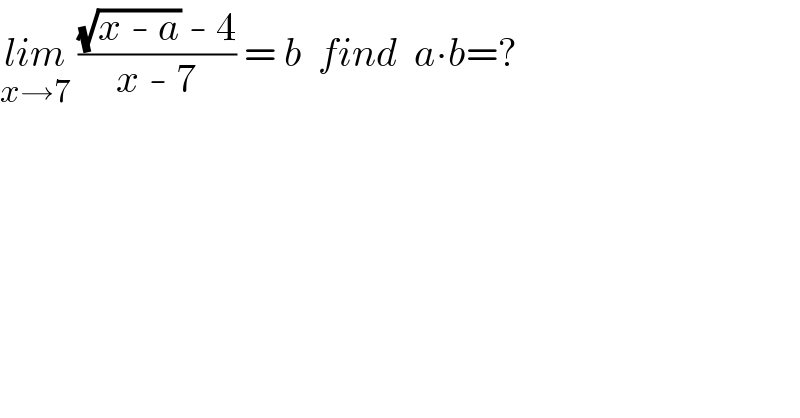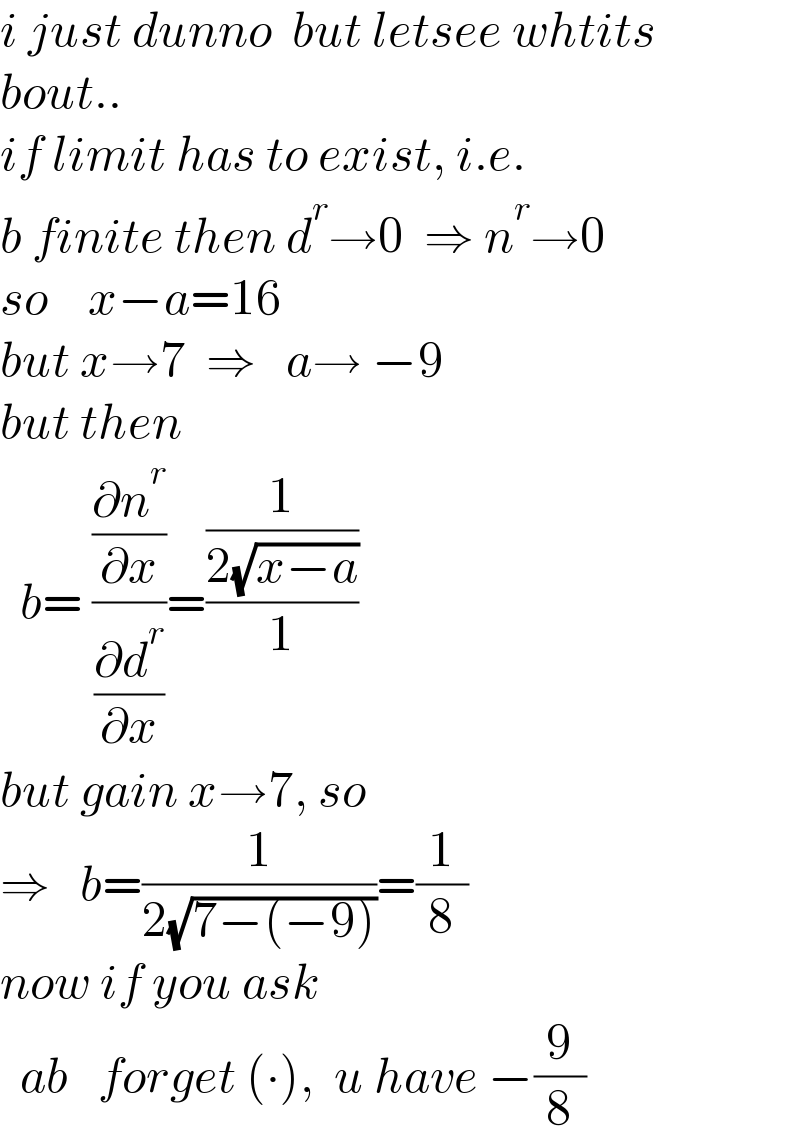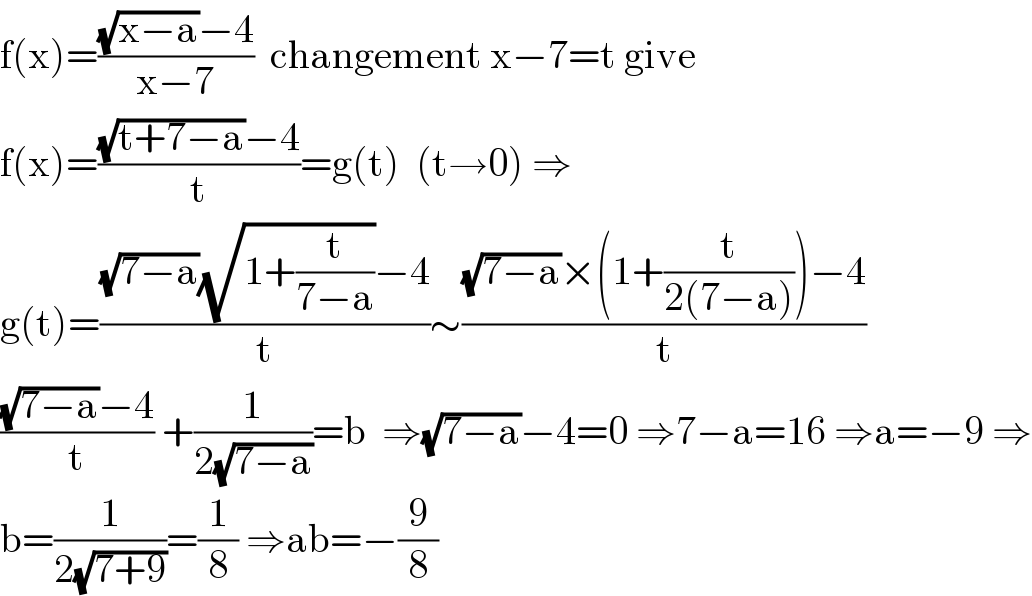
Question Number 146505 by mathdanisur last updated on 13/Jul/21

$$\underset{{x}\rightarrow\mathrm{7}} {{lim}}\:\frac{\sqrt{{x}\:-\:{a}}\:-\:\mathrm{4}}{{x}\:-\:\mathrm{7}}\:=\:{b}\:\:{find}\:\:{a}\centerdot{b}=? \\ $$
Answered by ajfour last updated on 13/Jul/21

$${i}\:{just}\:{dunno}\:\:{but}\:{letsee}\:{whtits} \\ $$$${bout}.. \\ $$$${if}\:{limit}\:{has}\:{to}\:{exist},\:{i}.{e}. \\ $$$${b}\:{finite}\:{then}\:{d}^{{r}} \rightarrow\mathrm{0}\:\:\Rightarrow\:{n}^{{r}} \rightarrow\mathrm{0} \\ $$$${so}\:\:\:\:{x}−{a}=\mathrm{16} \\ $$$${but}\:{x}\rightarrow\mathrm{7}\:\:\Rightarrow\:\:\:{a}\rightarrow\:−\mathrm{9} \\ $$$${but}\:{then} \\ $$$$\:\:{b}=\:\frac{\frac{\partial{n}^{{r}} }{\partial{x}}}{\frac{\partial{d}^{{r}} }{\partial{x}}}=\frac{\frac{\mathrm{1}}{\mathrm{2}\sqrt{{x}−{a}}}}{\mathrm{1}} \\ $$$${but}\:{gain}\:{x}\rightarrow\mathrm{7},\:{so} \\ $$$$\Rightarrow\:\:\:{b}=\frac{\mathrm{1}}{\mathrm{2}\sqrt{\mathrm{7}−\left(−\mathrm{9}\right)}}=\frac{\mathrm{1}}{\mathrm{8}} \\ $$$${now}\:{if}\:{you}\:{ask} \\ $$$$\:\:{ab}\:\:\:{forget}\:\left(\centerdot\right),\:\:{u}\:{have}\:−\frac{\mathrm{9}}{\mathrm{8}} \\ $$
Commented by mathdanisur last updated on 13/Jul/21

$${thanks}\:{Ser} \\ $$
Answered by mathmax by abdo last updated on 13/Jul/21

$$\mathrm{f}\left(\mathrm{x}\right)=\frac{\sqrt{\mathrm{x}−\mathrm{a}}−\mathrm{4}}{\mathrm{x}−\mathrm{7}}\:\:\mathrm{changement}\:\mathrm{x}−\mathrm{7}=\mathrm{t}\:\mathrm{give} \\ $$$$\mathrm{f}\left(\mathrm{x}\right)=\frac{\sqrt{\mathrm{t}+\mathrm{7}−\mathrm{a}}−\mathrm{4}}{\mathrm{t}}=\mathrm{g}\left(\mathrm{t}\right)\:\:\left(\mathrm{t}\rightarrow\mathrm{0}\right)\:\Rightarrow \\ $$$$\mathrm{g}\left(\mathrm{t}\right)=\frac{\sqrt{\mathrm{7}−\mathrm{a}}\sqrt{\mathrm{1}+\frac{\mathrm{t}}{\mathrm{7}−\mathrm{a}}}−\mathrm{4}}{\mathrm{t}}\sim\frac{\sqrt{\mathrm{7}−\mathrm{a}}×\left(\mathrm{1}+\frac{\mathrm{t}}{\mathrm{2}\left(\mathrm{7}−\mathrm{a}\right)}\right)−\mathrm{4}}{\mathrm{t}} \\ $$$$\frac{\sqrt{\mathrm{7}−\mathrm{a}}−\mathrm{4}}{\mathrm{t}}\:+\frac{\mathrm{1}}{\mathrm{2}\sqrt{\mathrm{7}−\mathrm{a}}}=\mathrm{b}\:\:\Rightarrow\sqrt{\mathrm{7}−\mathrm{a}}−\mathrm{4}=\mathrm{0}\:\Rightarrow\mathrm{7}−\mathrm{a}=\mathrm{16}\:\Rightarrow\mathrm{a}=−\mathrm{9}\:\Rightarrow \\ $$$$\mathrm{b}=\frac{\mathrm{1}}{\mathrm{2}\sqrt{\mathrm{7}+\mathrm{9}}}=\frac{\mathrm{1}}{\mathrm{8}}\:\Rightarrow\mathrm{ab}=−\frac{\mathrm{9}}{\mathrm{8}} \\ $$
Commented by mathdanisur last updated on 13/Jul/21

$${thank}\:{you}\:{Ser} \\ $$
